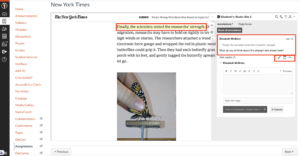Do you ever get the sense that students posting in their online discussions haven’t really engaged with the reading materials for that week? One way to encourage active engagement with course readings is to have students annotate directly in the article or textbook chapter that they are assigned. While it is common to see students annotating in their paper copies of their textbooks or readings, these aren’t easily shared with their peers or instructor. Of course, students could snap a photo of their handwritten annotations and upload that as a reading assignment task, though that does require additional steps on the part of both the student and instructor, and there is no interaction with others in the course during that process. However, it is possible to have students annotate their readings completely online, directly in any article on the web or in their ebook textbook. With this process, the annotations can also be seen by others in the course, if desired, so that students can discuss the reading all together or in small groups as they are reading an article or book chapter online. The benefit to this type of annotation online includes components of active learning, increased student interaction, and accountability for students in engaging with the course materials.
Active Learning
The shift to active learning is a bit like going from watching a soccer game on TV to playing a soccer game. Likewise, reading passively and reading to learn are two different activities. One way to get students actively reading to learn is to ask them to make connections from the course materials to their own lives or society, for example, which they then make into annotations in their readings. Annotation tasks require students to take actions and articulate these connections, all without the pressure of a formal assessment. Furthermore, many students arrive at college not knowing how to annotate, so teaching basic annotation practices helps students become more active and effective learners (Wesley, 2012).
Interaction
“Individuals are likely to learn more when they learn with others than when they learn alone” (Weimer, 2012). Discussion board activities are often where interaction with others in an online course takes place. However, rather than having students refer to a particular reading passage in their discussion board activity, they can simply highlight a passage and type their comments about it right there in the article, no discussion board assignment needed. Others in the course can also read participants’ annotations and reply. With some creative assignment design in Canvas, this can also be set up for small groups. Students may find this type of annotation discussion more authentic and efficient than using a discussion board tool to discuss a reading.

Accountability
A popular way to ensure that students have done the reading is to give them a quiz. However, this is a solitary activity and is higher-stakes than asking students to make targeted annotations throughout a reading. It may make more sense to guide them through a reading with specific annotation tasks. Being explicit about what pieces of the reading students should focus on can help them understand what they need to retain from the reading assignment.
Possible Activities
- Student-student interaction: Replace a discussion board activity with a collaborative annotation activity where students can annotate the article as they read. Then they can go back later in the week and reply to each other.
- Activate prior knowledge: Ask students to include one annotation related to what they already know about this topic.
- Evaluate sources: Find a pop-science article in your discipline that includes weak support for arguments or claims, for example. Ask students to identify the sources of support in the arguments and challenge the validity of the support. Perhaps they could even be tasked with adding links to reliable sources of support for your discipline in their annotation comments.
Nuts and Bolts
Two popular annotation tools are Hypothesis and Perusall. I would encourage you to test these out or ask your instructional designer about your needs and whether an annotation tool would be a good fit for your course learning outcomes.
Resources:
Wesley, C. (2012). Mark It Up. Retrieved from The Chronicle of Higher Education: https://www.chronicle.com/article/Mark-It-Up/135166
Weimer, M. (2012, March 27). Five Key Principles of Active Learning. Retrieved from Faculty Focus: https://www.facultyfocus.com/articles/teaching-and-learning/five-key-principles-of-active-learning/

